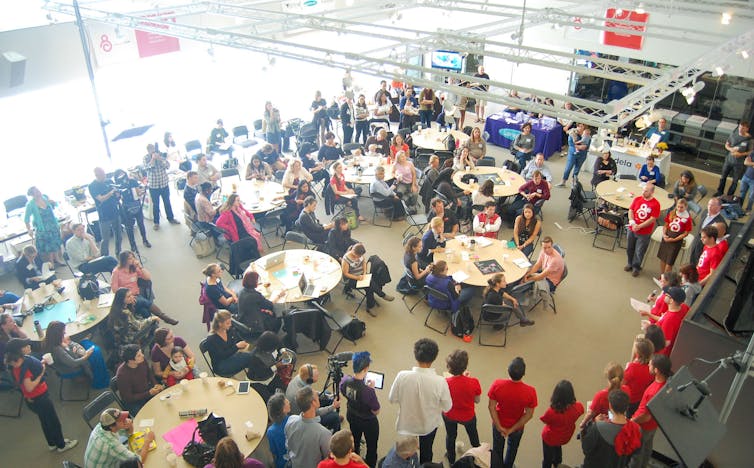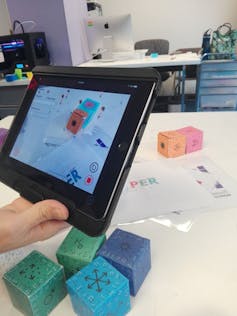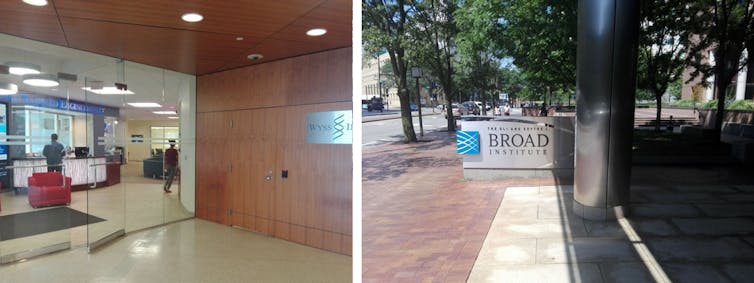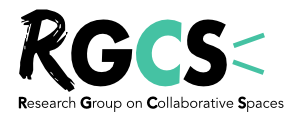By Aurore Dandoy, François-Xavier de Vaujany and Annie Passalacqua

Mason Marino, Che-Wei Wang, Andrew Whitacre / Flickr, CC BY
Aurore Dandoy, Université Paris Dauphine – PSL; Annie Passalacqua, HEC Montréal et François-Xavier de Vaujany, Université Paris Dauphine – PSL
As researchers and/or entrepreneurs, we have been absorbing cultural knowledge of collaboration, entrepreneurship, coworker and maker movements for a number of years. We often face and hear about how to become disruptive by two keywords: opening and hacking. Between July 25 and 28, 2018, we co-created a rich learning expedition organized by the Research Group on Collaborative Spaces (RGCS), at MIT and Harvard University, in Cambridge (Massachusetts). This alternative academic network focuses on topics about new work practices inspired by open science and citizen science cultures.
The starting point of our learning expedition was our astonishment: How can elite institutions (in particular, MIT and Harvard University) and an elite territory originate key collaborative practices and ideology such as hacking, open knowledge and open innovation? How to combine search for excellence, global leadership and selectivity with horizontal, transgressive, underground cultures of hacking and opening knowledge? Our objective was to understand this paradox with a set of planned and improvised visits and meetings (see the OWEE protocol) focused on MIT and Harvard University. Is it possible to be both conformist and transgressive?
We want first to share some astonishments before focusing on key moments and encounters we see as provisional answers to our initial question. We will thus not detail all trip and everything that happened but we want to share here some selected afterthoughts.
Three general astonishments about Harvard University and MIT
We found three practices particularly striking both at MIT and Harvard University and their relationship with opening and hacking knowledge.
Our first was observing how much students (undergraduate, graduate, master and PhD students) and their theses and projects were made visible and valuated by the institutions. Through this, we do not only mean rewarding them and evaluating them (e.g. with awards), but truly putting them at forefront of what the university is and does. At the MIT Museum, we participate in the Idea Hub workshop named Hypercube, which was part of a masters thesis from by the Media Lab. In many parts of MIT, students’ work is exhibited, part of the storytelling or simply visible on or from the street.

Author provided
Secondly, we were surprised that at a time of global tensions and an obsession for security, there was also a great openness in the semi-public and public spaces. It was easy to simply enter, meet people, ask questions, walk around, and have chance encounters. Even if a lot of doors inside were (hopefully) closed and secured, most places were truly open to the city, its movements, its events, its ideas. Literally, those two campuses are open to citizens.
In continuation to this, the third element we found surprising was serendipity. It felt to be a reality here we could almost touch. It was very easy to connect, move from one meeting to another, and collaborate. But here there was a surprise in the surprise: this has nothing to do with fashionable collaborative spaces nor with a particular urbanism. The Wyss Institute we visited or the Broad Institute do not appear at all as decompartmentalised, coworking-like or makerspace-like places. Their offices, meeting rooms and labs are extremely traditional (see pictures below). Nonetheless, collaborative practices occur. We were really surprised by how easy it was to meet and have by chance encounters (e.g. with a person who collaborated to the vaccine against cancer).

Author provided
Five key moments in our exploration of opening and hacking knowledge
To introduce and shed light on the identified paradox, we would like here to share five relevant moments of the learning expedition.
A transgressive interdisciplinary place: the Wyss Institute at Harvard
The first encounter we would like to communicate happened at the Wyss Institute “for Biologically Inspired Engineering at Harvard University”. This interdisciplinary place is inspired by nature. It uses biological principles or metaphors to innovate in the health sector. Our meeting took place in the morning of day two of our learning expedition. Two researchers, among whom the founding director of the Institute Donald Ingber, presented us the institute, its activities and organization. The institute adventure started right after the 2008 financial crisis with a $125 million donation. Being both inside and outside of Harvard is obviously an interstitiality which foster innovative collaborations. Can a university accept and host such transgressive attempts? Wouldn’t it be possible to host all those research activities inside a traditional department? Specificities of the organization seem to be based on autonomy, trust and close work with practitioners. Elsewhere, this would probably mean being on one personal academic territory or another. Wyss Institute appears to be a more neutral zone.
MIT tour storytelling: all about hacking culture
The second moment we would like to point out is the official campus tour of MIT (we also did Harvard official campus tour). Tours are key practices in the life of American universities. The meeting point of MIT campus tour was at the entrance of the main building with the famous dome. Our guide was a young undergraduate interested in Science and Technology Studies (STS). Extremely mature, with an already assured sense of public speaking, she produced the story-telling of the tour with a lot of practical, scientific and historical details. We learned everything about the facilities, accommodation, recruitment, history, teaching and research activities of MIT. But most of all, we learned about MIT culture. Two enlightened moments of the tour were focused on hack culture of MIT and they happened to be the two key parts of tour: a stop in front of the most emblematic place and the last stop in front of the iconic hacked police car. In both cases, she put the stress on the importance of small transgressions inside MIT community, impertinence and sense of humor embodied by hacks and hacking culture (see pictures below). We were particularly surprised to see and hear all these official narratives precisely about the topic of our learning expedition. This was beyond our expectations.
An intriguing iconic hackers space in the middle of the night
The third moment we would like to share is our chance to visit a hackerspace. At the end of day 2, we were looking for Tech Model Railroad Club (TMRC), an iconic, mythological place in hackers’ history, and incidentally, makers’ history. After three wrong places, we finally found the door and building in late evening. But it was closed. We did not see any way to come or call inside and we were waiting seated outside, waiting for someone entering or leaving the place. One of us went on the other side of the street and noticed something that looked like a makerspace with bikes and strange objects suspended in a big room. We went on the other side and knocked at a grimy window through which we guessed the presence of people inside. This was a lovely moment (see pictures below). Six makers (four men and two women) were working on a prototype of a small electric bike for an event the next day. We had a spontaneous conversation with one of them about the place, what it does, how membership was granted, how it was related to MIT teaching. The atmosphere was cool, warm and open. We came from nowhere, it was the evening and the street was already dark, but we felt really welcome. Indeed, TMRC was in the room next to the makerspace, so we also took time looking at it.
GAFAM unconventional open-office spaces
The fourth moment happened on the third day. We wanted to look also at more entrepreneurial and independent places. After visiting Cambridge Innovation Center (CIC) and before WeWork office spaces, we went to a GAFAM (fantasy name) office we spotted the day before, walking down the street. After discussion at welcome desk we did not manage to get in touch with anyone and were simply close to leaving when an employee left the building from the other entrance. He probably heard us speaking French and stopped. One of us asked him if he was part of the company, one thing to another, and he soon he invited us to visit their offices the next day. As we agreed to during the registration process, we cannot explain here what we saw, but again, we were surprised by the fluidity of everything here. Moving from a dream, a possibility to a concrete encounter.
A makerspace for social inclusion and innovation: D-Lab
The last and fifth moment was the visit of D-Lab. This unit is about social inclusion and social innovation. The main idea of the projects they work on is to co-produce with worldwide communities tools they need. Numerous accomplishment of the place were exhibited in the corridor: corn seller, mechanical washing machine, water treatment system… All largely based on material and handed-gestures. Our guide, who accepted to lead the visit just for us, deepened the story-telling of the projects and gave us opportunity to touch and to watch their experimentations in action. We were again surprised by the place’s openness. Everything was done to perform and materialise local activities for visitors. The inside was turned toward visitors. Because of another appointment, he trusted us to finish the tour alone and take a few pictures. Even the makerspace room was open to public, with simply a yellow line on the ground that needed to not be crossed for security reasons.
From encounters to learning: what did we bring back from Cambridge?
What about the initial paradox? Far from a barrier, the tension we stressed appear as a driver, an energy for the place. MIT and Harvard launch standards they both maintain and transgress in a polite, transparent, community-grounded way. Hacking alone in the dark, just for oneself is not enough. Community and society feedbacks are always expected. All campus and territory is a powerful storytelling machine. All world of worldwide science, technique and entrepreneurship is expected to be at MIT and Harvard. And in this summer we can testify that we experienced it crossing MIT campus and walking on Harvard campus. We saw big groups of children and teenagers coming to dream about MIT and Harvard. We ourselves dreamt of duplicating this tremendous spirit in our own institutions.
So, what will be our memory of this learning expedition whose two thirds of the people and places we visited have been improvised (see the OWEE protocol)? A big machine made to make one’s eyes shine. A funny, energic, largely outdoor and beyond any walls place likely to make dream any brilliant teenager and researcher who do want to participate to create a brave new world.
We thank all of our guides who opened their doors to us and answered our questions with passion and kindness. And we hope that might lead to cross-Atlantic open collaboration.![]()
Aurore Dandoy, Assistant researcher, Université Paris Dauphine – PSL; Annie Passalacqua, Business Development Strategist, HEC Montréal et François-Xavier de Vaujany, Professeur, PSL-Université Paris-Dauphine (DRM), Université Paris Dauphine – PSL
La version originale de cet article a été publiée sur The Conversation.
